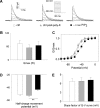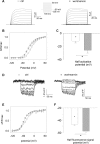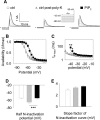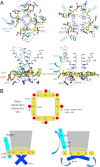Dual effect of phosphatidylinositol (4,5)-bisphosphate PIP(2) on Shaker K(+) [corrected] channels
- PMID: 22932893
- PMCID: PMC3476283
- DOI: 10.1074/jbc.M112.382085
Dual effect of phosphatidylinositol (4,5)-bisphosphate PIP(2) on Shaker K(+) [corrected] channels
Erratum in
- J Biol Chem. 2013 Apr 12;288(15):10951
Abstract
Phosphatidylinositol (4,5)-bisphosphate (PIP(2)) is a phospholipid of the plasma membrane that has been shown to be a key regulator of several ion channels. Functional studies and more recently structural studies of Kir channels have revealed the major impact of PIP(2) on the open state stabilization. A similar effect of PIP(2) on the delayed rectifiers Kv7.1 and Kv11.1, two voltage-gated K(+) channels, has been suggested, but the molecular mechanism remains elusive and nothing is known on PIP(2) effect on other Kv such as those of the Shaker family. By combining giant-patch ionic and gating current recordings in COS-7 cells, and voltage-clamp fluorimetry in Xenopus oocytes, both heterologously expressing the voltage-dependent Shaker channel, we show that PIP(2) exerts 1) a gain-of-function effect on the maximal current amplitude, consistent with a stabilization of the open state and 2) a loss-of-function effect by positive-shifting the activation voltage dependence, most likely through a direct effect on the voltage sensor movement, as illustrated by molecular dynamics simulations.
Figures








Similar articles
-
Phosphatidylinositol-4,5-bisphosphate (PIP(2)) stabilizes the open pore conformation of the Kv11.1 (hERG) channel.Biophys J. 2010 Aug 9;99(4):1110-8. doi: 10.1016/j.bpj.2010.06.013. Biophys J. 2010. PMID: 20712994 Free PMC article.
-
Phosphatidylinositol-4,5-bisphosphate, PIP2, controls KCNQ1/KCNE1 voltage-gated potassium channels: a functional homology between voltage-gated and inward rectifier K+ channels.EMBO J. 2003 Oct 15;22(20):5412-21. doi: 10.1093/emboj/cdg526. EMBO J. 2003. PMID: 14532114 Free PMC article.
-
KCNQ1 channels do not undergo concerted but sequential gating transitions in both the absence and the presence of KCNE1 protein.J Biol Chem. 2012 Oct 5;287(41):34212-24. doi: 10.1074/jbc.M112.364901. Epub 2012 Aug 20. J Biol Chem. 2012. PMID: 22908235 Free PMC article.
-
Involvement of the S4-S5 linker and the C-linker domain regions to voltage-gating in plant Shaker channels: comparison with animal HCN and Kv channels.Plant Signal Behav. 2014;9(10):e972892. doi: 10.4161/15592316.2014.972892. Plant Signal Behav. 2014. PMID: 25482770 Free PMC article. Review.
-
Use of voltage clamp fluorimetry in understanding potassium channel gating: a review of Shaker fluorescence data.Can J Physiol Pharmacol. 2009 Jun;87(6):411-8. doi: 10.1139/y09-024. Can J Physiol Pharmacol. 2009. PMID: 19526034 Review.
Cited by
-
Phosphatidylinositol 4,5-bisphosphate (PIP2) regulates KCNQ3 K+ channels by interacting with four cytoplasmic channel domains.J Biol Chem. 2018 Dec 14;293(50):19411-19428. doi: 10.1074/jbc.RA118.005401. Epub 2018 Oct 22. J Biol Chem. 2018. PMID: 30348901 Free PMC article.
-
Membrane Protein Structure, Function, and Dynamics: a Perspective from Experiments and Theory.J Membr Biol. 2015 Aug;248(4):611-40. doi: 10.1007/s00232-015-9802-0. Epub 2015 Jun 11. J Membr Biol. 2015. PMID: 26063070 Free PMC article. Review.
-
A Kir6.2 pore mutation causes inactivation of ATP-sensitive potassium channels by disrupting PIP2-dependent gating.PLoS One. 2013 May 20;8(5):e63733. doi: 10.1371/journal.pone.0063733. Print 2013. PLoS One. 2013. PMID: 23700433 Free PMC article.
-
A long QT mutation substitutes cholesterol for phosphatidylinositol-4,5-bisphosphate in KCNQ1 channel regulation.PLoS One. 2014 Mar 28;9(3):e93255. doi: 10.1371/journal.pone.0093255. eCollection 2014. PLoS One. 2014. PMID: 24681627 Free PMC article.
-
Regional flexibility in the S4-S5 linker regulates hERG channel closed-state stabilization.Pflugers Arch. 2014 Oct;466(10):1911-9. doi: 10.1007/s00424-013-1431-9. Epub 2014 Jan 10. Pflugers Arch. 2014. PMID: 24407947
References
-
- Hilgemann D. W., Feng S., Nasuhoglu C. (2001) The complex and intriguing lives of PIP2 with ion channels and transporters. Sci. STKE 2001, re19. - PubMed
-
- McLaughlin S., Wang J., Gambhir A., Murray D. (2002) PIP(2) and proteins: interactions, organization, and information flow. Annu. Rev. Biophys. Biomol. Struct. 31, 151–175 - PubMed
-
- Huang C. L., Feng S., Hilgemann D. W. (1998) Direct activation of inward rectifier potassium channels by PIP2 and its stabilization by G[β][γ]. Nature 391, 803–806 - PubMed
-
- Hilgemann D. W., Ball R. (1996) Regulation of cardiac Na+,Ca2+ exchange, and KATP potassium channels by PIP2. Science 273, 956–959 - PubMed
-
- Zhang H., Craciun L. C., Mirshahi T., Rohács T., Lopes C. M., Jin T., Logothetis D. E. (2003) PIP(2) activates KCNQ channels, and its hydrolysis underlies receptor-mediated inhibition of M currents. Neuron 37, 963–975 - PubMed
Publication types
MeSH terms
Substances
LinkOut - more resources
Full Text Sources

